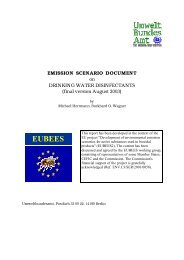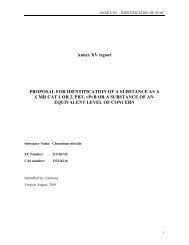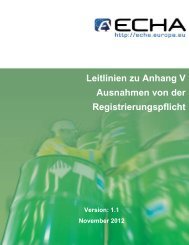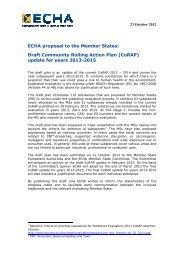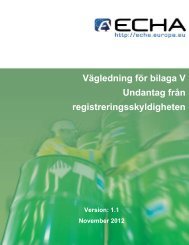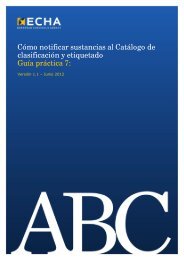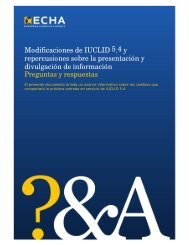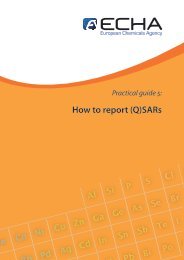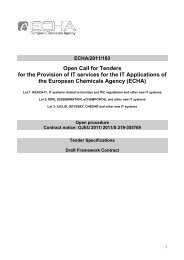Strategy For Limiting Risks Human Health Draft of ... - ECHA - Europa
Strategy For Limiting Risks Human Health Draft of ... - ECHA - Europa
Strategy For Limiting Risks Human Health Draft of ... - ECHA - Europa
You also want an ePaper? Increase the reach of your titles
YUMPU automatically turns print PDFs into web optimized ePapers that Google loves.
Developmental toxicity<br />
Cryolite was investigted for prenatal developmental toxicity in rats, mice and rabbits with the<br />
oral route <strong>of</strong> administration. While from the studies with rats and with rabbits there was no<br />
prenatal developmental toxicity, some indications for bent ribs and bent limb bones were<br />
reported from the mice study. These anomalies were only reported at dose levels showing<br />
severe maternal toxicity. Thus the effects are not considered to be indicative for a substance<br />
specific teratogenic potential <strong>of</strong> cryolite. During the two-generation study with rats,<br />
administering 0, 14, 42, 128 mg cryolite/kg/day in the diet, growth retardation in postnatal<br />
development was observed. Because this effect ocurred without any significant sign for<br />
systemic toxicity it is considered indicative for a specific toxic potential <strong>of</strong> cryolite adverse to<br />
postnatal development. The respective NOAEL in the diet study was 42 mg cryolite/kg/day.<br />
This value is taken forward for risk assessment. Data for other routes or human data are not<br />
available.<br />
Inhalation exposure<br />
Inhalation risk assessment will be based on the oral NOAEL <strong>of</strong> 42 mg cryolite/kg/day from<br />
the two-generation rat study. Taken forward to workers (bodyweight 70 kg) and taking into<br />
account oral absorption <strong>of</strong> 85% for animals and 100% inhalation absorption this value<br />
corresponds to an air concentration at the workplace <strong>of</strong> 250 mg cryolite /m 3 (42 mg/kg/day x<br />
70 kg x 0.85/1 / 10 m 3 ), assuming a respiratory volume <strong>of</strong> 10 m 3 for workers in 8 hours shift.<br />
The air concentration resembles the corrected NOAEC and gives the starting point for<br />
inhalation risk assessment.<br />
The following adjustment factors are applied for the identification <strong>of</strong> the reference MOS:<br />
(1) the allometric scaling factor for the rat is 4; (2) a default factor <strong>of</strong> 2.5 accounts for<br />
additional interspecies differences; (3) for intraspecies differences (workers) the default factor<br />
is 5. This gives a reference MOS <strong>of</strong> 50 (4 x 2.5 x 5). An adjustment for study duration is not<br />
deemed necessary. The critical inhalation exposure level at the workplace is identified as 5<br />
mg cryolite /m 3 (250/50).<br />
As can be seen from table 2.4 there is one inhalation scenario at risk (scenario 3: use in other<br />
industries). It has to be kept in mind though, that under the aspect <strong>of</strong> systemic toxicity the<br />
critical air concentration for repeated inhalation <strong>of</strong> cryolite is 1 mg/m 3 . If this would be kept,<br />
developmental risks would also be diminished.<br />
Dermal contact<br />
23<br />
Conclusion: iii<br />
Also dermal risk assessment is based on the NOAEL from the two-generation diet study in<br />
rats. Taking into account oral (85%) and dermal (10 %) absorption a value <strong>of</strong> 357 mg cryolite<br />
/kg/day (42 mg cryolite/kg/day x 0.85 / 0.1) is used as starting point for the dermal route.<br />
The following adjustment factors are applied for the identification <strong>of</strong> the reference MOS:<br />
(1) the allometric scaling factor for the rat is 4; (2) a default factor <strong>of</strong> 2.5 accounts for<br />
additional interspecies differences; (3) for intraspecies differences (workers) the default factor<br />
is 5. This gives a reference MOS <strong>of</strong> 50 (4 x 2.5 x 5). An adjustment for study duration is not<br />
deemed necessary. The critical dermal exposure level at the workplace is identified as<br />
7.1 mg cryolite/kg/day (357/50).






